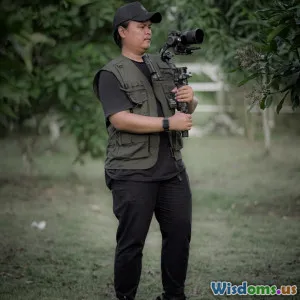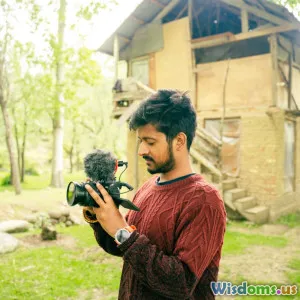
Five Ways to Make Your Short Film Stand Out at Festivals
8 min read Discover five expert strategies to make your short film shine at festivals and captivate both audiences and judges. (0 Reviews)
Five Ways to Make Your Short Film Stand Out at Festivals
Entering your short film into festivals can be both exhilarating and nerve-wracking. With thousands of talented filmmakers vying for attention, how do you ensure your work rises above the noise? Festivals are not just about showcasing films; they're celebrations of storytelling, style, and originality. To truly resonate with audiences and judges alike, your short film needs to do more than just exist; it must captivate.
In this comprehensive guide, we’ll dive into five definitive ways to make your short film stand out at festivals, supported by examples, data, and practical insights that empower you to take action.
1. Craft a Compelling and Unique Story
At its core, filmmaking is storytelling. According to a survey conducted by Slamdance Film Festival, films with original, relatable, or emotionally compelling narratives are 70% more likely to win audience awards. But what does it mean to craft a compelling story in under 30 minutes?
-
Avoid clichés: Even broad genres like horror or drama have been extensively explored. What fresh perspective can you offer? Take "Thunder Road" (2016), directed by Jim Cummings — a short film that blends dark comedy with emotional depth, offering audiences an unexpected character study.
-
Focus on character depth: Your protagonist’s journey should elicit empathy. Use concise yet emotionally rich dialogue and visual storytelling.
-
Incorporate universal themes: Themes like resilience, identity, or connection resonate often. Yet, make them personal. In "Skin" (2018), director Guy Nattiv beautifully tells a moral tale on racial bias packed within a 20-minute runtime.
-
Engage from the start: Opening scenes should grab attention. A strong hook within the first two minutes can reduce dropout when screening with large festival audiences.
2. Elevate Your Visual Style and Cinematography
Visual storytelling goes hand in hand with narrative but also serves as a standalone appeal to festival audiences who appreciate artistry and innovation.
-
Invest in lighting: Many festivals emphasize the visual polish of entries. Strategies like chiaroscuro lighting or naturalistic palettes create mood and depth. The Academy Award-winning short "The Silent Child" leveraged natural light to intensify intimacy.
-
Use unique camera techniques: Whether it’s the fluid long-take approach or innovative framing angles, a memorable visual style sticks with viewers. For instance, "Five Feet Apart" used tight framing and soft focus intentionally to reflect isolation.
-
Color grading matters: Consistent yet expressive color schemes can set tone and aid storytelling subtly. Films like "La Jetée" (1962) demonstrate how monochrome causes heightened emotional attachment.
-
Sound design as visual extension: Crisp, atmospheric sound complements visuals and immerses the audience, a factor appreciated in festivals judged by seasoned professionals.
3. Engage Your Audience with Festival-Friendly Pacing and Length
Festival juries and audiences differ from theatrical viewers. They often view multiple films in tight succession.
-
Keep it concise: Whilst some festivals allow films up to 40 minutes, many short film categories cap between 10-20 minutes. Short films with runtimes 10-15 minutes strike a balanced engagement timeframe.
-
Pacing is crucial: Every scene and frame must justify screen time. Use tight editing to maintain momentum, ensuring there’s no room for boredom. For example, at Sundance, pacing is often praised, which helps immerse viewers quickly.
-
Clear beginning, middle, and end: Even with limited time, a well-defined narrative arc aids retention—ambiguous or overly experimental pacing can alienate juries.
4. Leverage Festival-Specific Marketing and Networking Strategies
Success at festivals isn’t solely about the film medium; it also hinges on how well you position the film within the festival’s ecosystem.
-
Tailor submissions wisely: Research festival themes, audience demographics, and prior winners. Align your film’s message with the festival’s ethos. For instance, environmental-themed films excel at Sundance or Environmental Film Festival Europe.
-
Create compelling press kits: Include your film’s synopsis, director’s statement, high-quality stills, and behind-the-scenes content.
-
Utilize social media for buzz: Platforms such as Instagram and Twitter are vital for short films. Engage with relevant hashtags (#ShortFilmFestival, #IndieFilm), tag festivals, and share teasers.
-
Network at festivals effectively: Attend panels, mixers, and screening Q&As professionally. Networking can result in vital partnerships or distribution offers.
5. Submit Strategically and Prepare for Technical Excellence
Submitting a film is more than uploading a video file.
-
Quality file formats: Use industry-standard formats such as ProRes or high-bitrate H.264. Video quality influences projection and jury impressions.
-
Follow submission guidelines to the letter: Festivals can disqualify entries for incorrect formats, missing information, or late submissions.
-
Choose the right festivals: Submit to a combination of A-list (e.g., Venice, Toronto), mid-tier, and niche festivals to increase exposure chances. According to The Film Festival Alliance, filmmakers attending a mix of festival tiers report a 30% higher success rate.
-
Prepare subtitles and translations: International festivals demand captions. Professionally done subtitles expand reach and judge understanding.
Conclusion
Standing out at film festivals requires more than just shooting a good short film; it’s about crafting a narrative that connects, presenting it visually with finesse, engaging audiences through well-executed pacing, and navigating the festival landscape with strategic marketing and submission precision.
By integrating these five approaches—strong storytelling, visual artistry, festival-savvy pacing, promotional acumen, and technical professionalism—you not only enhance your film’s chances of screening but significantly improve its impact and longevity within the competitive festival world.
As acclaimed director Ava DuVernay advises, "The power of film is endless—it’s portable, immediate, and everywhere. Let your film be unforgettable."
Are you ready to reshape your short film experience and see it shine on the festival stage?
References:
- Slamdance Film Festival Audience Reports, 2022.
- The Film Festival Alliance Survey, 2023.
- "Skin" Short Film – Academy Award-Winning Analysis.
- Interviews with Jim Cummings (Director, "Thunder Road") and Guy Nattiv (Director, "Skin").
Rate the Post
User Reviews
Popular Posts



















